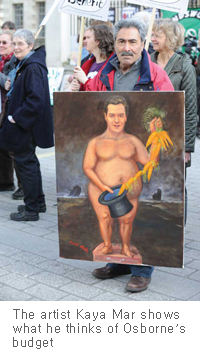 Tax-relief cap will curtail major gifts
Tax-relief cap will curtail major gifts
British government’s proposal to close tax loopholes upsets museums and their biggest donorsMajor projects planned by the UK’s leading arts organisations and museums are threatened by tax changes that the British government is proposing in an attempt to close loopholes enjoyed by the super-rich. In his March budget, the chancellor of the exchequer George Osborne announced a tax-relief cap on annual donations to charity above £50,000 or a quarter of an individual’s income, whichever is greater. Critics argue that this will discourage very large charitable gifts, and pressure to force a U-turn was mounting as we went to press.
The cap could have a particularly serious impact on large museum building projects, which are highly reliant on £1m-plus donations from private individuals and trusts. These include the extension to Tate Modern (a £215m project, which still needs £54m), the British Museum extension (£135m, needing £15m), the development of the Design Museum in Kensington (£80m, needing £18m), upgrading Tate Britain (£45m, needing £10m), the Victoria and Albert Museum’s (V&A) project in Dundee (£45m, needing £30m) and the V&A extension in Exhibition Road (£40m, needing £25m).
Donations at risk Growing pressure from the charities, including those raising money for health, education and the elderly, may force the British government to rethink the proposals. In the cultural sector, Arts Council England warns that donors are already considering pulling out of important projects. A council spokeswoman says that major donors have contacted some of the arts organisations it helps fund to say that if this cap is introduced, “they will not be able to support them at previous levels”. As a result, “at least £80m of regular donations to several of our largest organisations could be at risk”.
The chancellor announced a limit on all uncapped tax reliefs to ensure that the very wealthy pay a higher proportion of tax. This affects several forms of relief, including donations to charities. A Treasury spokesman suggested that a few people are abusing the system by using foreign charities set up by themselves to reduce their tax liabilities.
Critics of the cap say that it will be a major disincentive to philanthropy at a time of government cuts. They say there is little evidence of abuse, and, where it exists, it should be tackled directly. The new system is likely to be devastating for charities because it will hit the big donors. A survey by the Charities Aid Foundation estimates that of the £11bn donated in the UK in 2009/10, 45% came from 7% of donors.
The National Council for Voluntary Organisations gives an example of the impact that the new system could have on a very wealthy arts patron who earns £800,000 a year and responds to an appeal by donating £1m.
Under the current Gift Aid concession, this would result in £1,250,000 for the recipient. The individual also gets personal tax relief of £312,500. It effectively costs the donor £687,500 to give £1,250,000 to charity. Under the new proposals, the donor would only be able to claim tax relief on 25% of their income, or £200,000. This means the same gift will effectively cost them £950,000. Most donors would therefore respond to an appeal with a considerably lower contribution (or possibly decide against giving at all).
Stephen Deuchar, the director of the Art Fund, says the new cap could have a “devastating impact”. A fund spokeswoman adds that it will have “a disproportionate impact on the arts, museums and cultural charities, which are often dependent on a small pool of larger-value donors”.
Mark Getty, the chairman of London’s National Gallery, says there is “no question the gallery and many other organisations will suffer”. Martin Roth, the director of the V&A, says the change will “adversely impact” potential donors.
Michael Dixon, the chairman of the National Museums Directors’ Conference, is “deeply concerned” about the tax-relief cap. A spokeswoman for the organisation points out that the proposal comes at a time when the government wants museums to get “a greater contribution from philanthropy in running the nation’s great cultural institutions”. The conference is preparing a detailed submission to the government on the possible effects of the proposed tax change.
The Museums Association is equally worried. Mark Taylor, its director, says: “It seems bizarre that the government is restricting tax relief on large donations at precisely the time they want to increase philanthropy.”
The government has stressed the importance of private support for the arts. The March budget introduced the Cultural Gifts Scheme, which offers tax benefits to those who donate pre-eminent objects to museums and galleries (it is a parallel system to Acceptance in Lieu, which covers inheritance tax).
The new £100m Catalyst scheme matches private donations to cultural organisations with Lottery and government money, with the first awards due to be made later this month. The budget also included a concession allowing those who leave more than 10% of their bequests to charity to have their estates subjected to a lower rate of inheritance tax.
Second thoughts? Critics of the proposed cap say the government has often drawn parallels with the situation in the US, where, partly because of greater tax incentives, wealthy donors give a much higher proportion of their income to charity. In America those earning more than £150,000 a year give eight times more to charity than those in Britain.
The tax-relief cap is due to come into effect in April 2013. But after the storm of protest from charities and donors, the Treasury was having second thoughts. A spokesman says it will “explore with philanthropists ways to ensure that this measure will not impact significantly on charities that depend on large donations”. The Treasury minister David Gauke says: “There will be a proper consultation over the summer and then draft legislation produced in the autumn.”
 Tax-relief cap will curtail major gifts
Tax-relief cap will curtail major gifts